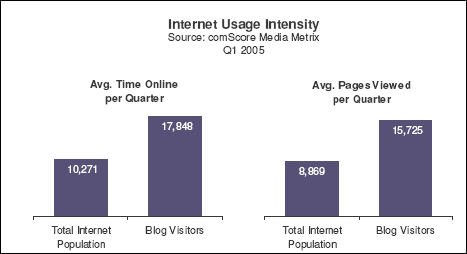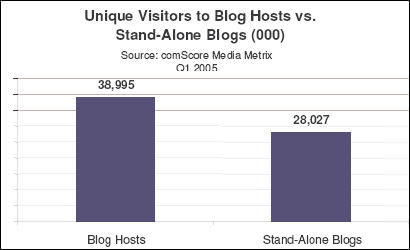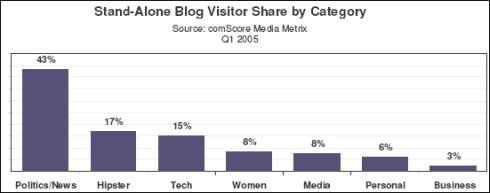Gawker sales people tell advertisers that the blog audience is young, rich and influential. It’s a reasonable assumption. Blog readers are early adopters, and one would assume that they would have a profile much like the early internet audience. We hoped that contention was true, because it’s at the core of the pitch: that blogs can help marketers reach people, above all, young guys, who are abandoning network television, and never really got into the newspaper reading habit.
But I have to confess that we only had some data from Burst reader surveys, and anecdotes, to support the case. And one survey, by Blogads, was contradictory, showing high household income, but a surprisingly mature age profile. So, along with Six Apart, we asked one of the leading market research firms to conduct a more rigorous study.
Und die Resultate? Es gibt ein Draft (.pdf, 120 KB) von comScore Networks, aber es ist noch nicht ganz fertig. Zur Erhebungsgröße mehr auf dem Six Apart Typeblog. Gawker und Konsorten wird es aber jetzt schon freuen:
Key Findings
- 50 million U.S. Internet users visited blog sites in the first quarter of 2005. That is roughly 30% of all U.S. Internet users and 1 in 6 of the total U.S. population
- Five hosting services for blogs each had more than 5 million unique visitors in that period, and four individual blogs had more than 1 million visitors each
- Of 400 of the biggest blogs observed, segmented by seven (nonexclusive) categories,
political blogs were the most popular, followed by „hipster“ lifestyle blogs, tech blogs and
blogs authored by women- Compared to the average Internet user, blog readers are significantly more likely to live in wealthier households, be younger and connect to the Web on high-speed connections
- Blog readers also visit nearly twice as many web pages as the Internet average, and they are much more likely to shop online
Das wird natürlich die Problogger alle freuen, was die Werbeattraktivität auf dem US Markt angeht:

Neue Stellenangebote

|
Growth Marketing Manager:in – Social Media GOhiring GmbH in Homeoffice |
|

|
Content Creator Social Media (m/w/d) CSU-Bezirksverband Augsburg in Augsburg |
|

|
Social Media Manager (Fokus: Community Management Supervision) (w/m/d) – befristete Elternzeitvertretung für 18 Monate Yello Strom GmbH in Köln |
Unterstützt durch diese Aussage:
The study also found that blog visitors are 30 percent more likely to buy products or services online. While less than 40 percent of the total Internet population made an online purchase in Q1 2005, 51 percent of blog visitors did. The average blog visitor who bought online spent approximately six percent more than the average online buyer.
Was mich etwas erstaunt ist, daß gehostete Blogs (sowas wie Typepad) mehr Visits im Schnitt aufweisen als selbst gehostete Blogs (zB Movable Type).

Spannend ist auch eine Übersicht, was für Themen welchen Traffic generieren:

via ProBlogger








[…] interessanter Zusatzartikel zur Blogger-Studie von ComScore .pdf (siehe Vorbericht) auf Business Blog Consulting: Clarifying Research on comScore Blog Study: How to Measure Blog Tags: comscore, traffic, blog measuring, gawker, sitemeter, visitors, visits […]
[…] Wie werde ich aber zum bekannten Blogger? Welcher Content ist spannend? Du musst diese Frage schon anders formulieren: Kann man Topblogger werden? Und festzustellen bleibt – gerade das machen die Beispiele oben klar – es gibt kein Patentrezept. Es kostet definitiv viel, viel Zeit, viele Artikel, viel Übung, viel Ausdauer und viel Gespür fürs Leservolk. Und manchmal einfach nur Glück. Wer sich über seine Leser absolut keine Gedanken machen will (weder mit dem Kopf noch mit dem Bauch), ohne sich aber in eine Abhängigkeit zu begeben, wird es ganz schwer haben, sich hochzubloggen. Ganz ehrlich aber: Wer dieses Ziel anstrebt, kann es eigentlich nicht schaffen. Geh mal davon aus, daß es zZt 250.000 Blogs in D gibt. Und nur 10 gehören zu der Spitze des Eisbergs. Hallo? Die Chance ist 1:25.000 und sie wird stetig schlechter, da immer mehr Blogs tagtäglich dazukommen. Trostpflaster: Es gibt eine amerikanische, sehr umfangreiche Studie, in der u.a. auch die Interessen der Blogger selbst ausgwertet werden. Das ist doch schon mal ein Anhaltspunkt. […]
[…] Zu erwarten war ja eigentlich, daß der Unterschied im Bereich Technik groß sein wird, was mich aber wundert, ist das No.1 Thema “Business” bei Blogs… das entspricht mE nicht den Tatsachen, wenn ich mir die US Blogs vor Augen halte. Es kan natürlich sein, daß durch die Auswahl der 15.000 Blogs überproportional viele über Business schreiben. Ob dann aber die Untersuchung repräsentativ-schlüssig genug ist??? Schaut man sich die Studie an (sieh Grafik am Ende), sieht es ganz anders aus. […]